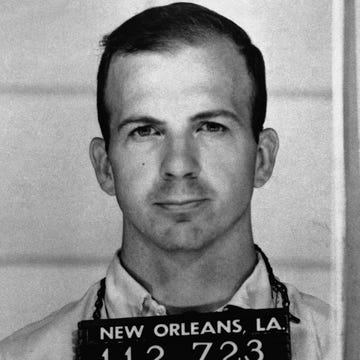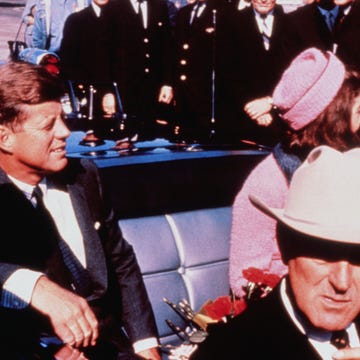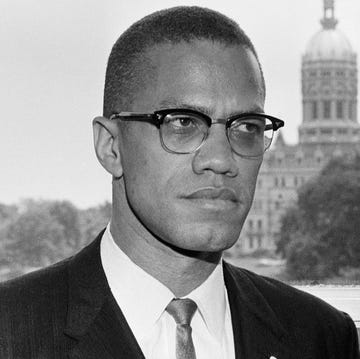1831-1881
Latest News: Netflix’s Death by Lightning Revisits James A. Garfield’s Assassination
The Netflix mini-series Death by Lightning will dive deep into the true story of President James A. Garfield’s assassination. The show will chronicle the life and death of the 20th U.S. president, portrayed by actor Michael Shannon, following his unexpected nomination as the Republican presidential nominee and his narrow election victory in 1880.
Garfield was shot by office-seeker Charles J. Guiteau (Matthew Macfadyen) just a few months into his term in July 1881. Guiteau believed he was owed a job in Garfield’s administration for showing his support for the president during his election campaign.
While this was common under the patronage system at the time, Garfield supported civil service reform and took a strong stance against patronage, in favor of merit-based hiring. After being rejected, Guiteau sought to remove Garfield from office by killing him, making his second-in-command, Chester A. Arthur (Nick Offerman in Death by Lightning), the 21st President of the United States of America.
“The idea of civil service reform and waging a battle to clean up the grift in our government—this is something that Garfield very much stood on the front lines of in his time,” Death by Lightning creator Mike Makowsky told Netflix’s Tudum. “In 1881, it feels like America is sort of standing at a crossroads between the past and what the future of this country is going to look like, and it’s up to [people like Garfield] to really define how America, 100 years after its inception, is going to look and what kind of society they’re going to be.”
Garfield eventually succumbed to his injuries in September 1881, after his physician, Dr. Willard Bliss (Željko Ivanek), repeatedly tried to remove the bullet with unsterilized fingers and instruments. The 49-year-old left behind his wife, Lucretia “Crete” Garfield (Betty Gilpin) and their five children who lived into adulthood: James, Harry, Irvin, Abram, and Mollie (Laura Marcus).
Death by Lightning arrives on Netflix November 6.
Who Was James A. Garfield?
James A. Garfield served as the 20th President of the United States. The Ohio native rose from humble beginnings to serve as a college president, a nine-time congressman, and a military general before his election to the U.S. presidency in 1881. Garfield’s presidential agenda of civil service reform and civil rights was cut short when he was shot by disgruntled office seeker Charles J. Guiteau just a few months into his term. He later died of his injuries in September 1881.
Quick Facts
FULL NAME: James Abram Garfield
BORN: November 19, 1831
DIED: September 19, 1881
BIRTHPLACE: Cuyahoga County, Ohio
SPOUSE: Lucretia Garfield (1854-1881)
CHILDREN: James, Harry, Irvin, Eliza, Abram, Edward, and Mary “Mollie”
ASTROLOGICAL SIGN: Scorpio
Early Life and Education
James Abram Garfield was born on November 19, 1831, in a log cabin near the village of Orange in Cuyahoga County, Ohio. His father, Abram Garfield, a farmer known for his wrestling abilities, died when he was just an infant, leaving his mother, Eliza Ballou Garfield, in charge of the family farm. The youngest of four living children, Garfield grew up in poverty with his siblings Thomas, Mehitabel, and Mary. His brother, Jimmy, who he was named after, passed away before he was born. While his mother later remarried a man named Alfred Belding, it eventually ended in divorce.
As a child, Garfield took an interest in reading and history, but didn't initially want to pursue higher education. With dreams of becoming a sailor, he left home at the age of 16 and began working as a mule driver on a canal boat in Cleveland, to his mother's dismay. After falling overboard more than a dozen times, Garfield contracted malaria and returned home only six weeks later.
As he recovered from the illness, his mother convinced him to go back to school. In 1848, the young Garfield enrolled in Geauga Seminary in Chester, where he excelled in his academics, particularly in Latin and Greek. It was there that he first met his wife, Lucretia Rudolph. During this time, he also worked as a teacher and a carpenter to support himself.
While Garfield grew up attending church, he had no real interest in religion until he experienced a reawakening in 1850 and was baptized into the Disciples of Christ, a protestant denomination his parents belonged to. He went on to attend the Western Reserve Eclectic Institute (now Hiram College) from 1851 to 1854. There, Garfield was popular among his classmates and reconnected with Lucretia. Continuing his study of classical languages, he later enrolled at Williams College in Massachusetts, where he graduated with honors in 1856.
Early Political Career
After completing his studies, Garfield returned to the Eclectic Institute as a classics professor and was soon promoted to school president. At this point, he had become an ordained minister at the Disciples of Christ. In his spare time, Garfield spoke publicly in support of the Republican Party and began to privately study law. In 1859, he embarked on a career in politics when he was elected to the Ohio State Senate as a Republican, becoming the youngest member of the legislature at 28 years old.
During his time in the state Senate, he was a vocal opponent of slavery. A staunch abolitionist, Garfield campaigned for Abraham Lincoln in the 1860 presidential election and publicly urged the government to use military force to stop southern states from seceding. “I am inclined to believe that the sin of slavery is one of which it may be said that without the shedding of blood there is no remission,” he said. Garfield's term came to an end in 1861 and he soon passed the Ohio bar exam to become an attorney.
Civil War and U.S. House of Representatives
That summer, Garfield took an active role in the Civil War. Although he had no prior military experience, he organized the 42nd Ohio Infantry Regiment in the Union Army and was commissioned as a lieutenant colonel in August 1861. Just weeks later, he ascended to the rank of colonel. While training his regiment, Garfield joined the Freemasons in Columbus.
After helping the Union secure victory in the Battle of Middle Creek in January 1962, he was promoted again to brigadier general and given command of the 20th Brigade of the Army of Ohio at the Battle of Shiloh in April 1862.
Garfield's political career continued during wartime. In October 1862, he won a seat in the U.S. House of Representatives, representing Ohio's 19th Congressional District. After the election, Garfield relocated to Washington, where he developed a close alliance with Treasury Secretary Salmon P. Chase. He became a member of the Radical Republicans, led by Chase, and found himself frustrated by moderates, which included Lincoln.
Garfield not only favored abolition but also believed that the leaders of the rebellion had forfeited their constitutional rights. He supported the confiscation of southern plantations and the punishment of rebellion leaders.
Following President Lincoln's assassination, Garfield attempted to ameliorate the strife between his own Radical Republicans and the new president, Andrew Johnson. When Johnson undermined the Freedman's Bureau, however, Garfield rejoined the Radicals, subsequently supporting Johnson's impeachment.
After Democrats won a majority in the 1874 election, Garfield became the House minority leader, and he soon established himself as both a leader and a sharp political strategist.
In March 1879, the congressman gave one of the most pivotal speeches in his career when he spoke against the majority for attaching riders, or additional provisions, to appropriations bills that aimed to defund federal oversight of elections in the South, weakening protections for Black voters. “If they are not permitted to force upon the other house [the Senate] and the Executive [the President] against their consent…this refusal will be considered a sufficient ground for starving this government to death,” he said.
Wife Lucretia Garfield and Children
Garfield married Lucretia “Crete” Rudolph in November 1858. The couple, who had met at school, had seven children together, five of whom live to be adults.
Their first child, Eliza, died of diphtheria at 3 years old. The Garfields oldest son, Harry, went on to become the president of Williams College, while their second son, James, later served as Secretary of the Interior. Their daughter Mary, who went by Mollie, married Garfield's private secretary Joseph Stanley Brown, while theirs sons, Irvin and Abram, became an attorney and architect, respectively. The youngest child, Edward “Neddie,” died of whooping cough at the age of 2.
Following the sudden death of Eliza, whom they affectionately called Trot, Garfield was consumed with grief and had an affair with a woman in New York. He quickly confessed his infidelity to Lucretia and the couple worked to repair their marriage. They remained married until his assassination in 1881. Nearly four decades later, Lucretia died of pneumonia in March 1918.
1880 Presidential Election
Following nine terms in the House, Garfield was elected to the U.S. Senate by the Ohio legislature in January 1880, but he never took his seat. At the Republican National Convention that June, he was unexpectedly selected as the Republican presidential nominee.
Facing a deadlock between two rival factions, the conservative Stalwarts (led by New York Senator Roscoe Conkling) and the moderate Half-Breeds, the convention was at a standstill, with frontrunners former President Ulysses S. Grant and Senator James G. Blaine of Maine failing to obtain enough votes to be nominated. Though Garfield had attended the convention to nominate Treasury Secretary John Sherman, he found himself as the party's nominee on the 36th ballot as a compromise candidate.
The deeply divided convention nominated Chester A. Arthur, a Stalwart Republican, for the vice presidency. In November 1880, Garfield and Arthur were narrowly elected to office over Democratic candidate Winfield S. Hancock, winning the popular vote by less than 10,000 votes.
Presidency
Garfield was inaugurated as the 21st president of the United States in March 1881. In his inaugural address, the new president focused on the importance of popular education and civil rights for Black Americans. “There can be no permanent disfranchised peasantry in the United States,” he said. “Freedom can never yield its fullness of blessings so long as the law or its administration places the smallest obstacle in the pathway of any virtuous citizen.”
At the start of his term, the new president managed to reassert the superiority of the office of the president over the U.S. Senate on the issue of executive appointments. Attempting to unify both factions of the party, Garfield submitted a list of cabinet appointments to the Senate, which included several of Conkling's friends, as well as Blaine, who became his Secretary of State. However, he also appointed William H. Robertson as the Collector of the Port of New York, which Conkling opposed. While Conkling tried to get the Senate to block the nomination, he ultimately failed and resigned in protest.
“This . . . will settle the question whether the president is registering clerk of the Senate or the Executive of the United States . . . shall the principal port of entry . . . be under the control of the administration or under the local control of a factional senator,” Garfield said. He also appointed several former slaves, including Frederick Douglass, to prominent government positions.
During his limited time in office, Garfield initiated reform of the Post Office Department, pursuing an investigation into the Star Route Scandal, involving the bribery and corruption of federal postal officials. He also pledged to commit himself to the cause of civil rights and recommended a universal education system funded by the federal government, in part to empower African Americans.
At the same time, Garfield's presidency was dominated by the patronage system, and he was constantly bombarded with demands from office-seekers looking for job in exchange for their support. The president, however, was a supporter of civil service reform, and took a strong stance against patronage, which ultimately led to his assassination.
Assassination and Death
One such office seeker, Charles J. Guiteau, believed he was owed a position in the Garfield administration after he strong-armed Republican officials into letting him give a speech in support of Garfield during his presidential campaign. Guiteau specifically sought the position of American consulship to Paris, but after repeated denials to his request, he grew resentful and set out to remove Garfield from office.
On July 2, 1881, just 100 days after the president's inauguration, Guiteau shot Garfield in the back at Washington's Baltimore and Potomac train station. He immediately surrendered to authorities, announcing, “I am a Stalwart. Arthur is now president of the United States.”
Garfield clung to his life as former Civil War surgeon Dr. Willard Bliss tried to remove the bullet, but his repeated attempts to probe the wound with unsterilized fingers and instruments ultimately did more harm than good. Meanwhile, Garfield's administration was torn on how to proceed, with Arthur refusing to take over executive duties.
Garfield finally succumbed to a fatal heart attack, massive hemorrhaging, and blood poisoning on September 19, 1881. He was 49 years old. Garfield's 199-day term is the second shortest in U.S. presidential history. He left behind his wife, Lucretia, and their five children who had survived infancy.
Garfield's tragic assassination later gave way to the Pendleton Civil Service Act, which Arthur signed in 1883. The law established a merit-based hiring system for federal jobs.
Quotes
- A brave man is a man who dares to look the Devil in the face and tell him he is a devil.
- [What] is freedom? Is it the bare privilege of not being chained?... If this is all, then freedom is a bitter mockery, a cruel delusion.
- The truth will set you free, but first it will make you miserable.
- Now more than ever before, the people are responsible for the character of their Congress. If that body be ignorant, reckless, and corrupt, it is because the people tolerate ignorance, recklessness, and corruption.
- The chief duty of government is to keep the peace and stand out of the sunshine of the people.
- I mean to make myself a man, and if I succeed in that, I shall succeed in everything else.
- I am inclined to believe that the sin of slavery is one of which it may be said that without the shedding of blood there is no remission.
- There can be no permanent disfranchised peasantry in the United States. Freedom can never yield its fullness of blessings so long as the law or its administration places the smallest obstacle in the pathway of any virtuous citizen.
Fact Check: We strive for accuracy and fairness. If you see something that doesn’t look right, contact us!
The Biography.com staff is a team of people-obsessed and news-hungry editors with decades of collective experience. We have worked as daily newspaper reporters, major national magazine editors, and as editors-in-chief of regional media publications. Among our ranks are book authors and award-winning journalists. Our staff also works with freelance writers, researchers, and other contributors to produce the smart, compelling profiles and articles you see on our site. To meet the team, visit our About Us page: https://www.biography.com/about/a43602329/about-us
Catherine Caruso joined the Biography.com staff in August 2024, having previously worked as a freelance journalist for several years. She is a graduate of Syracuse University, where she studied English literature. When she’s not working on a new story, you can find her reading, hitting the gym, or watching too much TV.















